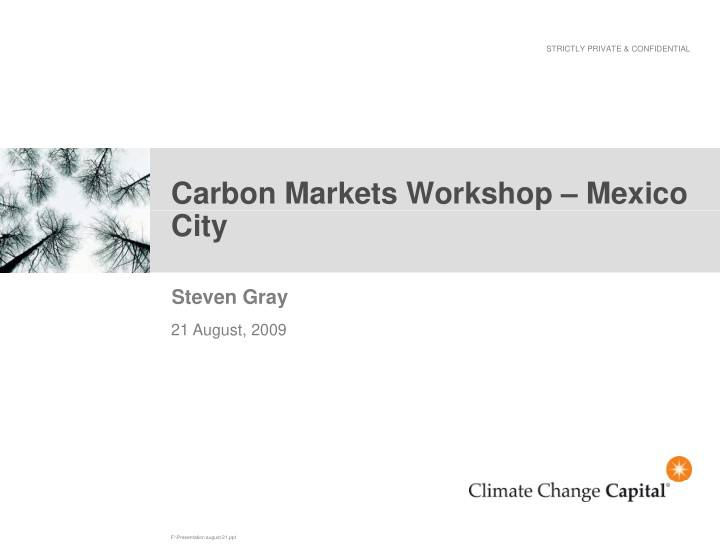



STRICTLY PRIVATE & CONFIDENTIAL Carbon Markets Workshop – Mexico City Steven Gray 21 August, 2009 F:\Presentation august 21.ppt
Commitments to reduce CO 2 emissions are the drivers for demand in carbon credits for demand in carbon credits Commitments by 2020 Long term commitments � � Serious commitments have been made by countries to Even longer term commitments have been made by some reduce CO 2 emissions mainly by developed economies of the countries individually and jointly � � Developing economies are also making commitments in These commitments set out the market demand up to 2020 the longer term beyond the Kyoto Protocol Longer term reduction targets Reduction targets by 2020 EU -20% from 1990 levels EU -80% from current levels by 2050 Japan -80% from current levels by 2050 Japan -15% from 2005 levels US -17% from 2005 levels US -83% from 2005 levels by 2050 Australia -15% from 2000 levels UK -80% from 1990 levels by 2050 Mexico -50% from 2000 levels by 2050 Canada -20% from 2006 levels Switzerland -20% to -30% from 1990 levels G8 -50% from 1990 levels by 2050 Norway -30% from 1990 levels MEF* Agreement on scientific view that global average temperature above pre-industrial levels not to exceed 2 degrees China -20% energy consumption per national i income between 2005 to 2010 b t 2005 t 2010 *MEF (The Major Economies Forum) include: Australia, Brazil, Brazil Reduce deforestation by 70% by 2017 Canada, China, EU, France, Germany, India, Indonesia, Italy, Japan, South Korea, Mexico, Russia, South Africa, UK and US South Korea -21% to -30% from BAU levels Russia Russia -10% to -15% from 1990 levels 10% to 15% from 1990 levels Sources: Project Catalyst, Lazarowicz, Global Carbon Trading, Point Carbon, UNFCC, MEF 2 F:\Presentation august 21.ppt
Development of carbon markets at multilateral, regional and national levels will facilitate emission reduction activities to meet the commitments meet the commitments Canada ETS (2013*) State level scheme St t l l h Pre 2013: WCI Sectors covered: EU ETS (2005) • Power Sectors covered: Japan ETS (2013*) • Industry • Power Volantary ETS started • Industry already Sectors covered: • Power US ETS (2013) • Industry State level schemes • Upstream Oil and Gas pre 2013 • RGGI, California, WCI MGA WCI, MGA Sectors covered: • Power Australia ETS (2011) •Transportation Sectors covered: • Industry will be • Power included later • Industry Industry • Upstream Oil and Gas • Agriculture - LATER Kyoto based CDM/JI (2008) •Project based credits generated in emerging economies and ETS implementation NZ ETS (2011*) developed economies committed to Sectors covered: Completed p caps caps • Power During Kyoto •Green house gases include: CO 2 , • Industry Post Kyoto CH 4 , N 2 O, SF 6 , HFC, PFC • Upstream Oil and Gas • Agriculture *Estimated implementation of mandatory ETS • Forestry 3 F:\Presentation august 21.ppt
State and Trends of the Carbon Market State and Trends of the Carbon Market 4 F:\Presentation august 21.ppt
State and Trends of the Carbon Market State and Trends of the Carbon Market 5 F:\Presentation august 21.ppt
6 CDM Project Types CDM Project Types F:\Presentation august 21.ppt
7 CDM Project Types CDM Project Types F:\Presentation august 21.ppt
Reform of the CDM Reform of the CDM Reform issues � Improvement of the administration of the CDM to make it more business friendly, � Improvement of the administration of the CDM to make it more business friendly, efficient and transparent; � Improvement of the environmental integrity of the CDM to guarantee the additionality of emissions reductions; � Scaling up the CDM beyond a project-by-project approach; and � S li th CDM b d j t b j t h d � Moving beyond a ‘one-size-fits-all’ approach to enable differentiation between developing countries, including moving beyond offsetting. Likely evolution � Increased standardisation of CDM is inevitable � Lower transaction costs � Baselines below BAU guarantee environmental integrity and move away from zero sum game of offsetting � Easy to scale � Easy to scale � Installation level instead of activity level so closer to emissions trading � What is the interface with policy (changing the E+/E- rule)? 8 F:\Presentation august 21.ppt
Role of carbon finance in policy co-financing Role of carbon finance in policy co financing € per tonne EUA or CER price p Domestic policy or international financial products Cost of abatement Carbon technology C finance D M Deployment 9 F:\Presentation august 21.ppt
Evolution of carbon finance away from project-based offsets offsets Inside Marrakech Amendment of Marrakech BAU baseline (full incremental cost) Beyond BAU (‘own’ contribution) ETS in No domestic regulation Domestic regulation or incentives 2020? Project based Installation based International MRV and issuance National MRV and issuance Sectoral crediting combined with standards Sectoral crediting combined with standards Project based CDM with Project-based CDM with or incentives standardised sectoral baselines 10 F:\Presentation august 21.ppt
Contact Climate Change Capital Contact Climate Change Capital CCC Head Office Climate Change Capital 3 More London Riverside London London SE1 2AQ United Kingdom Tel: +44 (0)20 7939 5000 Fax: +44 (0)20 7939 5030 www.climatechangecapital.com 11 F:\Presentation august 21.ppt
Recommend
More recommend